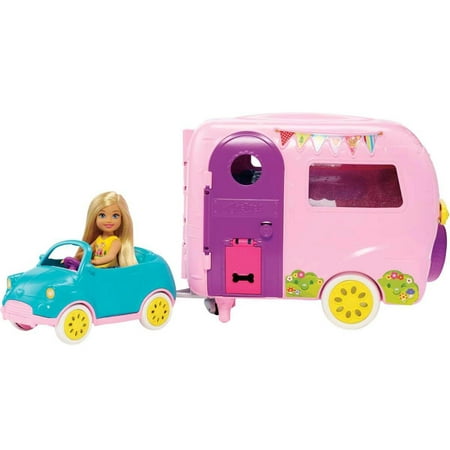Barbie Estate Malibu House Playset with 25+ Themed Accessories
The Barbie Malibu House playset is ready for imaginations to move right in with cool transformations and lots of storytelling pieces! The Barbie dollhouse opens to reveal so many play spaces and double-the-fun features. Kids can make the 2-story, 2-foot wide dollhouse their own with more than 25 pieces to decorate its 6 rooms – transformation elements bring even more possibilities into the playset. The living room transforms to an entertainment room, the shower becomes a vanity and the ceiling becomes a bunk bed to make room for 4 Barbie sisters to sleep. Classic features are there, too: the bathroom has a toilet with sink and shower; the fridge and oven open in the kitchen; and a fence piece sports a grill decal to bring the play outside. The doll-sized furniture and accessories include classic items with signature style, like a pink couch or white circle dining table, and smaller pieces that add big fun, like place settings and a gameboard. Some pieces have a handle a doll can hold (sold separately) and/or are designed with plug-and-play features that make it easy for active play or quick clean up. Fold the house to store away with ease. Tell stories where Barbie doll is hanging with her sisters, having sleepovers or backyard BBQs, celebrating a birthday, holiday or any day! There are endless stories to tell and limitless ways to explore living in the Barbie Malibu House because when a girl plays with Barbie, she imagines everything she can become! The Barbie Malibu House comes with 25+ accessories that include furniture and household items; doll not included. Colors and decorations may vary.








Barbie Estate Malibu House Playset with 25+ Themed Accessories:Age Range: 3 Years and UpImaginations can move right in to the Barbie Malibu House — the dollhouse opens to create a play space more than 2 feet wide!The 2 stories feature 6 rooms — a kitchen, dining room, living room, bedroom, bathroom and outdoor patio — plus transformation features make some rooms 2-in-1!Flip the wall in the living room to create an entertainment room, swing open the bathroom vanity to reveal the shower and flip down the bedroom ceiling to transform it into a bunk bed to make room for 4 sisters to sleep!More than 25 accessories can be arranged and rearranged to explore design or tell a story — some pieces have a handle a doll can hold and/or plug-and-play design to let kids immerse themselves in role-play and storytellingFurniture includes a sofa, coffee table, dining table and 4 chairs; accessories include place settings, food, bathroom items, a sleeping bag and game boardWith a big footprint and lots of pieces, this Barbie dollhouse makes a great gift for kids ages 3 years and olderBest. Roommate. Ever! Move right in with Barbie® Estate dollhouses, furniture and other toys and watch big dreams reach new heights!





Reviews
There are no reviews yet.